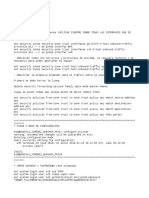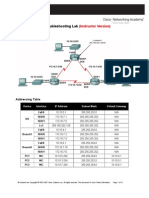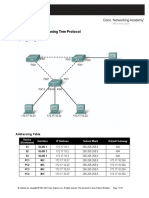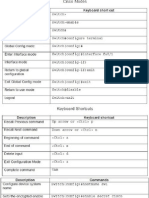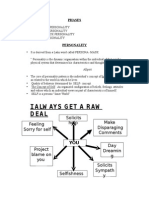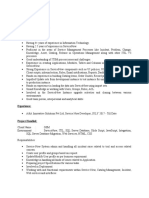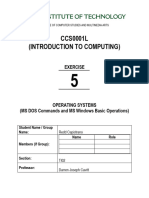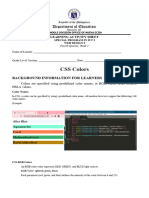VTP Server Configuration on switch 1
Switch> en
Switch# config t
Switch (config)#hostname Server
Server (config)#vtp mode server
Server (config)#vtp domain testing.com
Server (config)#int range f0/1-4
Server (config-if-range)#switchport mode trunk
Server (config-if-range)#exit
Server (config)#exit
Server # vlan database
Server(vlan)#vlan 2 name admin
Server (vlan)#vlan 3 name AC
Server (vlan)#vlan 4 name HR
VTP Client configuration on switch 2
Switch> en
Switch#config t
Switch (config)#hostname client1
Client1 (config)#vtp mode client
Client1 (config)#int range f0/1 -10
Client1 (config-if-range)#switchport access vlan 2
Client1 (config-if-range)#exit
Client1 (config)#
VTP Client configuration on switch 3
Switch> en
Switch# config t
Switch(config)# hostname Client2
Client2 (config)#vtp mode client
Client2 (config)#int range f0/1 -10
Client2 (config-if-range)#switchport access vlan 3
Client2 (config-if-range)#exit
Client2 (config)#
VTP Client configuration on switch 4
Switch> en
Switch# config t
Switch(config)# hostname Client3
Client3 (config)#vtp mode client
Client3 (config)#int range f0/1 -10
Client3 (config-if-range)#switchport access vlan 4
Client3 (config-if-range)#exit
Client3 (config)#
Configuration for Intervlan communication on
Router1
Router >en
Router # conf t
Router (config)#hostname Router1
Router1(config)#int s0/0
Router1(config-if)#ip add 10.0.0.1 255.255.0.0
Router1(config-if)#clock rate 64000
Router1(config-if)#no shut
Router1(config-if)#exit
Router1(config)#int f0/0
Router1(config-if)#no shut
Router1(config-if)#exit
Router1(config)#int f0/0.1
Router1(config-subif)#encapsulation dot1q 2
Router1(config-subif)#ip add 10.1.0.1 255.255.0.0
Router1(config-subif)#no shut
Router1(config-subif)#exit
Router1(config)#int f0/0.2
Router1(config-subif)#encapsulation dot1q 3
Router1(config-subif)#ip add 10.2.0.1 255.255.0.0
Router1(config-subif)#no shut
Router1(config-subif)#exit
EIGRP configuration for communication between
Router 1 and Router2
On Router1
Router >en
Router # conf t
Router (config)#hostname Router1
Router1(config)#enable pass cisco
Router1(config)#line vty 0
Router1(config-line)#login
Router1(config-line)#password cisco
Router1(config-line)#exit
Router1(config)#int s0/0
Router1(config-if)#ip add 10.0.0.1 255.255.0.0
Router1(config-if)#clock rate 64000
Router1(config-if)#no shut
Router1(config-if)#exit
Router1(config)# int f0/0
Router1(config-if)#no shut
Router1(config-if)#exit
Router1(config)#int f0/0.1
Router1(config-subif)#encapsulation dot1q 2
Router1(config-subif)#ip add 10.1.0.1 255.255.0.0
Router1(config-subif)#no shut
Router1(config-subif)#exit
Router1(config)#int f0/0.2
Router1(config-subif)#encapsulation dot1q 3
Router1(config-subif)#ip add 10.2.0.1 255.255.0.0
Router1(config-subif)#no shut
Router1(config-subif)#exit
Router1(config)#router eigrp 100
Router1(config-router)#net 10.0.0.0
Router1(config-router)#net 10.1.0.0
Router1(config-router)#net 10.2.0.0
Router1(config-router)#no auto-summry
Router1(config-router)#passive-interface f0/0
Router1(config-router)#exit
Router1(config)#
On Router2
Router >en
Router # conf t
Router (config)#hostname Router2
Router2(config)#enable pass cisco
Router2(config)#line vty 0
Router2(config-line)#login
Router2(config-line)#password cisco
Router2(config-line)#exit
Router2(config)#int s0/0
Router2(config-if)#ip add 10.0.0.2 255.255.0.0
Router2(config-if)#clock rate 64000
Router2(config-if)#no shut
Router2(config-if)#exit
Router2(config)# int f0/0
Router2(config-if)#ip add 10.4.0.1 255.255.0.0
Router2(config-if)#no shut
Router2(config-if)#exit
Router2(config)#router eigrp 100
Router2(config-router)#net 10.0.0.0
Router2(config-router)#net 10.4.0.0
Router2(config-router)#no auto-summry
Router2(config-router)#passive-interface f0/0
Router2(config-router)#exit
Router2(config)#
ACL configuration for specific communication on
router1
Router1(config)#access-list 110 permit tcp host 10.1.0.2 host 10.4.0.1 eq 23 (port
number of telnet)
Router1(config)#access-list 110 deny tcp any any en 23 (port number of telnet)
Router1(config)#access-list 110 permit ip any any
Router1(config)#int f0/0
Router1(config-if)#ip access-group 110 in


